Norvic Philatelics - GB New
Stamps and Special Postmarks
The House of Stewart - 23
March 2010 - stamps and miniature sheet
Two sets of Kings &
Queens stamps will be issued in 2010. The House of Stewart is
the third in a series that features the Kings
and Queens of England, Scotland and after 1603 the United Kingdom.
The first in the series was the Houses
of
Lancaster and York, and the
second was the House of
Tudor.
With this
third instalment the series moves north of the border to the
Stewart Kings who ruled Scotland from 1406 up until the death of
Elizabeth I in 1603. With no direct descendants, Elizabeth
became the last monarch of the House of Tudor and King
James VI of Scotland acceded to the throne of England. This created The
Union of the Crowns which brought England and Scotland under one
monarch. James was the first cousin (twice removed) of
Elizabeth and he was also the great grandson of Henry VIII’s
sister Margaret Tudor who married James IV of Scotland. As
the first of the Stuart Kings of England, James VI/I will be the only
monarch to feature in two sets of the Kings and Queens stamps. He will
also appear on the House of Stuart stamps issued in June. This, the
fourth in the Kings and Queens series, looks at the Kings and Queens
from James I up until the death of Queen Anne in 1714.
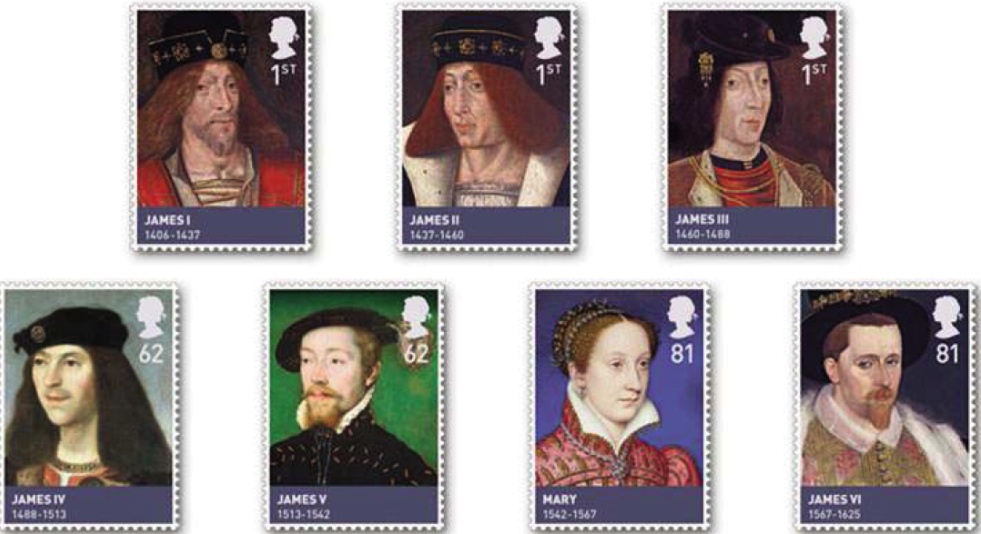
|
1st
class: James I
(1406-37), James II (1437-60)
& James III (1460-88);
62p*
James IV (1488-1513) &
James V (1513-42);
81p*
Mary (1542-1567) &
James VI (1567-1625)
|
|
|
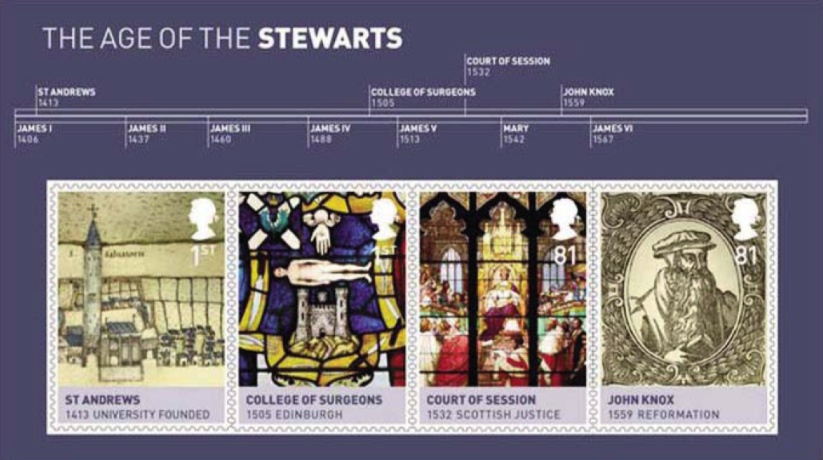
|
The MS takes a separate
look at the life and times of the age, featuring events and
individuals
from the reigns.
The
events featured are:
1st
class
Founding in 1413 of St Andrews
University
and in 1505 of the College of
Surgeons
in Edinburgh.
81p development
of the Scottish legal system of justice (the Court
of Session),
& John
Knox, a leading figure in the
Reformation in 1559.
The border design
features a timeline of the period.
|
| Acknowledgements:
portraits
of James I, James II and James III by unknown artists ©
Scottish National Portrait Gallery; James IV, 1626–34, Daniel
Mytens © Private Collection; James V, c.1537, Corneille de
Lyon © Private Collection; Mary Queen of Scots, 1558,
François Clouet, The Royal Collection © 2009 Her
Majesty Queen Elizabeth II; James VI, 1595, Adrian Vanson
(attributed)© Scottish National Portrait Gallery.
MS: S Andre sive Andreapolis Scotiae Universitas
Metropolitana, c.1580, John Geddy (1571–94) ©
National Library of Scotland; stained-glass window at the Royal
College
of Surgeons, Edinburgh, 1897, by Moxon & Carfrae,
photography by Peter Wood; Great South Window at Parliament
House,
Edinburgh, 1868, artist unknown, photography by Peter Wood; John
Knox,
1505–72, 1580, artist unknown (after Adrian Vanson)
© National Galleries of Scotland |
Background
on the stamps
1st
Class1st Class – James I (1406-1437)
James I (1394 – 21
February 1437) was nominal King of Scotland from 4 April 1406 until his
death, although his effective reign only began in May 1424.
He spent the earlier part of his reign as a prisoner in
England. On his release he made moves
to create a strong centralised monarchy in Scotland, and was
assassinated by dissident nobles.
1st
Class – James II (1437-1460).
James II of Scotland (16 October
1430 – 3 August 1460) was the son of James I of Scotland and
of Joan Beaufort (daughter of John Beaufort, 1st Earl of Somerset and
of Margaret Holland). He gained the nickname "Fiery face"
because of a conspicuous vermilion birthmark on his face. He
was killed by the accidental explosion of one of his own cannon at the
siege of Roxburgh Castle in 1460.
1st
Class - 1st
Class – James III (1460-1488)
James III (1451/2 – 11
June 1488) was an unpopular and ineffective monarch owing to an
unwillingness to administer justice fairly, a policy of pursuing
alliance with England, and a disastrous relationship with nearly all
his extended family. By 1479 this alliance was collapsing. In
1482 leading his subjects against an English invasion, James was
arrested at Lauder Bridge. He was imprisoned in Edinburgh
Castle, and a new regime, led by 'lieutenant-general' Albany, became
established. James regained power, by December 1482 but he
became estranged from his wife, Margaret of Denmark, and increasingly
his eldest son, favouring his second son. Matters came to a head in
1488 when he faced an army raised by the disaffected nobles at the
Battle of Sauchieburn, where he was defeated and killed. His heir, the
future James IV, took arms against his father, provoked by the
favouritism given to his younger brother
62p – James IV
(1488-1513)
James IV (17 March 1473 – 9 September 1513) was King of Scots
from 11 June 1488 to his death. He is generally regarded as the most
successful of the Stewart monarchs of Scotland, but his reign ended
with the disastrous defeat at the Battle of Flodden Field, where he
became the last monarch from Great Britain to be killed in battle.
62p
– James V (1513-1542)
James V (c. 10 April 1512 – 14 December 1542) was King of
Scots from 9 September 1513 being just 17 months old when James IV died
at Flodden Field, until his premature death at the age of thirty, which
followed the Scottish defeat at the Battle of Solway Moss.
81p
– Mary (1542-1567)
Mary (popularly known as Mary, Queen of Scots) (8 December 1542
– 8 February 1587) was the only surviving legitimate child of
King James V. She was six days old when her father died and made her
Queen of Scots. In 1558, she married Francis, Dauphin of
France, who ascended the French throne as Francis II in 1559. However,
Mary was not Queen of France for long; she was widowed on 5 December
1560. After her husband's death, Mary returned to Scotland,
arriving in Leith in 1561. Four years later, she married her first
cousin, Henry Stuart, Lord Darnley. Their union was unhappy and in
1567, Darnley was found dead in the garden at Kirk o'Field, after a
huge explosion in the house. She then married James Hepburn, 4th Earl
of Bothwell, who was generally believed to be Darnley's murderer.
Following an uprising against the couple, Mary was imprisoned in Loch
Leven Castle on 15 June and forced to abdicate the throne in favour of
her one-year-old son, James VI.
After an unsuccessful attempt to regain the throne, Mary fled to
England seeking protection from her father's first cousin, Queen
Elizabeth I, whose kingdom she hoped to inherit. Elizabeth, however,
ordered her arrest, because of the threat presented by Mary, who was
considered the rightful ruler of England by many English Catholics.
After a long period of custody, she was tried and executed for treason
following her involvement in three plots to assassinate Elizabeth.
81p
– James VI (1567-1625)
James VI (19 June 1566 – 27 March 1625) was King of Scots as
James VI from 1567 to 1625, and King of England and Ireland as James I
from 1603 to 1625. He became King of Scotland as James VI on
24 July 1567, when he was just thirteen months
old, succeeding his mother Mary, Queen of Scots. Regents governed
during his minority, which ended officially in 1578, though he did not
gain full control of his government until 1581. On 24 March 1603, as
James I, he succeeded the last Tudor monarch of England and
Ireland, Elizabeth I, who died without issue. He then ruled the kingdom
of England, Scotland, and Ireland for 22 years, often using the title
King of Great Britain, until his death at the age of 58
Miniature
Sheet
1st1st Class – St
Andrews
Until the 15th century, the
people of Scotland went to England or the Continent for a university
education. Wishing to improve training of priests in his diocese, in
1410 the Bishop of St Andrews allowed teaching to start in his city.
Papal approval of new universities was difficult to obtain, but the
Scots used the split in the Church between supporters of rival popes to
obtain a formal charter in 1413.
1st
Class – College of Surgeons
In 1505, the Barber Surgeons of Edinburgh were given the Seal of Cause
and incorporated as a Craft Guild to promote and maintain the high
standards of their trade. King James IV’s personal interest
in the new science of medicine guaranteed his support, and in October
1506 a Royal Charter confirmed its formal establishment. Today it
remains one of the world’s oldest surgical associations.
81p
– Court of Session
The supreme civil court of Scotland originated during the reign of
James I in ‘sessions’ of parliamentary committees
for civil justice. By the reign of James IV a permanent panel of judges
had emerged, but it was only in 1532 that the body was formalised, when
James V created the College of Justice with 15 professional
‘Lords of Session’ funded by a tax on the Church.
81p
– John Knox
After time as a galley slave, John Knox became a preacher in England.
In 1553 he fled to Geneva, but six years later he returned to Scotland
and had a key role in the revolution against French influence and
Catholicism. As minister of Edinburgh, he helped to devise the
framework of Scotland’s Protestant Church, but died in 1572
with his plans unrealised.
Technical details:
The
designs are by Atelier
Works, and the 27 x 37mm stamps are printed in lithography by Cartor
Security
Printers, Meacé, France, in sheets of 25/50, perf 14 x 14.
The miniature sheet is 123 x 70mm, also perf 14 x 14.
All images
are Copyright Royal Mail 2010.
Products
available:
Mint set
Mint miniature sheet
Presentation Pack (set & MS)
Set on PO FDC with any postmark shown
MS on PO FDC with any postmark shown
Set of 11 Stamp Cards unused
Special
Postmarks
Postmarks available for the day of issue will be shown here.
these may not be to scale.
These
postmarks cannot be obtained after the date of issue.
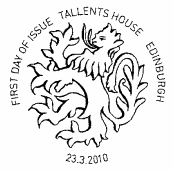
|
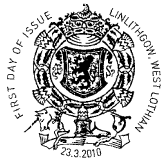
|
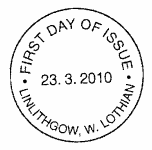
|
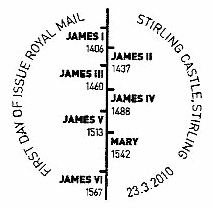 |
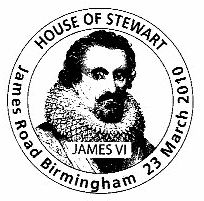
|
Ref FD1011
Philatelic Bureau Official Postmark |
Ref FD1012 Linlithgow,
West Lothian Official Postmark |
Ref FD1012N
West Lothian non-pictorial postmark. |
Ref S11671 First day of
issue Stirling Castle Timeline postmark |
Ref M11667
House of Stewart, James Road, Birmingham - showing James VI |
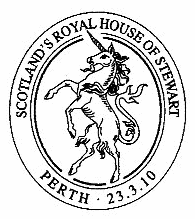
|

|
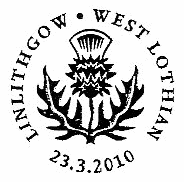
|
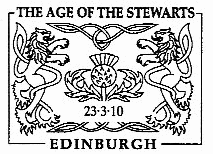
|
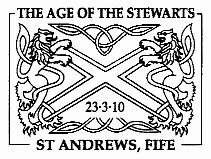
|
| Ref S11676
Perth |
Ref S11677
Scone, Perthshire |
Ref S11673 Linlithgow |
Ref L11674 Edinburgh |
Ref L11675 St
Andrews, Fife |
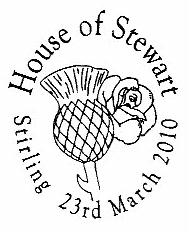 |
 |
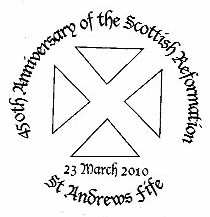 |
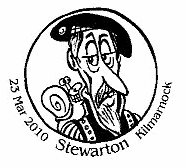
|
 |
| Ref S11672 Stirling |
Ref S11670 - Jedburgh |
Ref S11678 St Andrews,
Fife |
S11679 Stewarton,
Kilmarnock |
Ref: S4653
St Giles' Cathedral, Edinburgh |
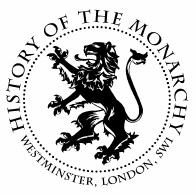 |
Ref L11551
History of the Monarchy, Westminster, London SW1
|
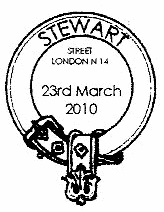 |
Ref L11664
Stewart Street, London N14
|
|
If you would like to know when
this page is updated, please use the ChangeDetection panel next to the
stamp images.
If
you have any questions about these stamps please email
us.
NB: all
emails should be acknowledged in 1-2 days unless the office is closed.
If you do not receive an acknowledgement please email us from a
different address (eg hotmail, gmail).
This page updated 16 March
2010


















